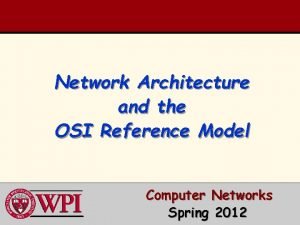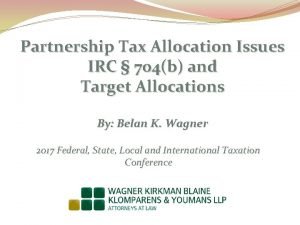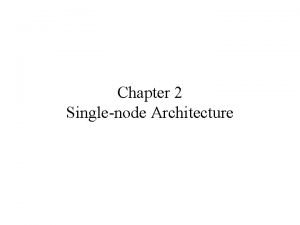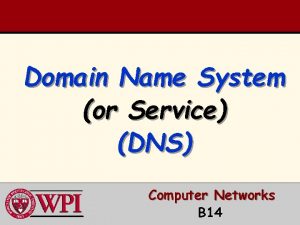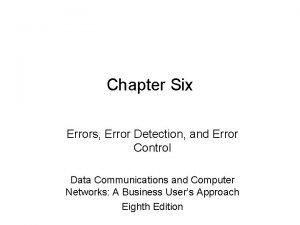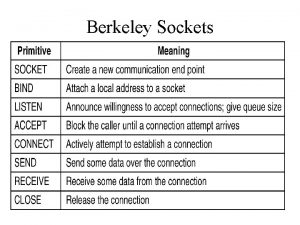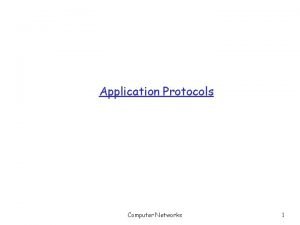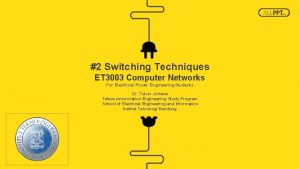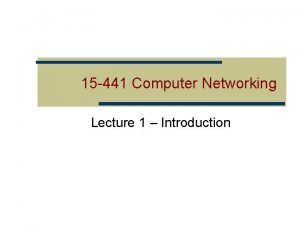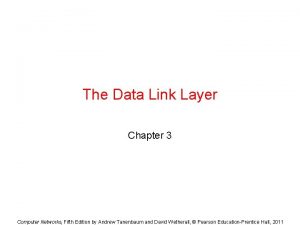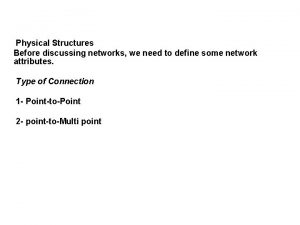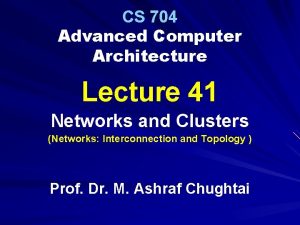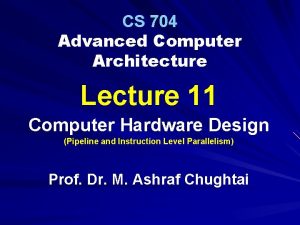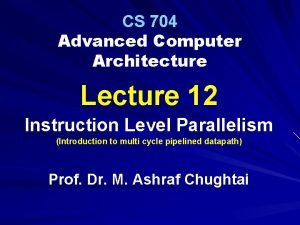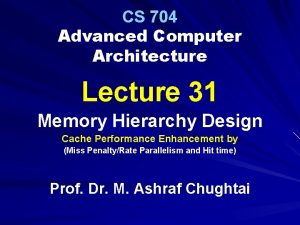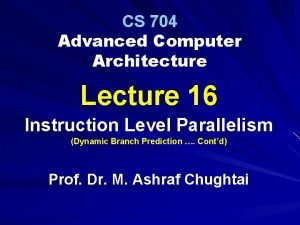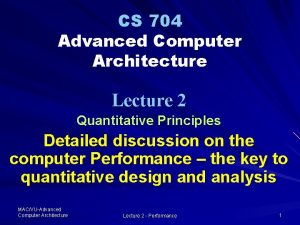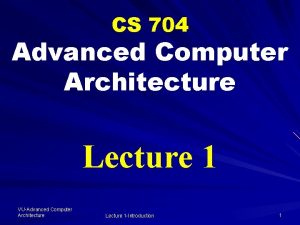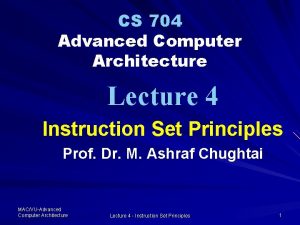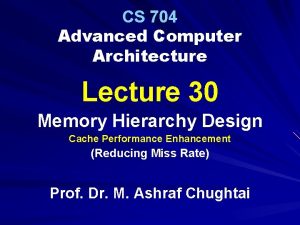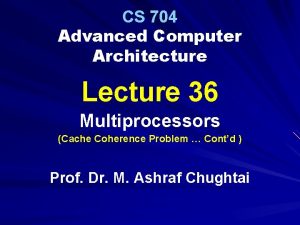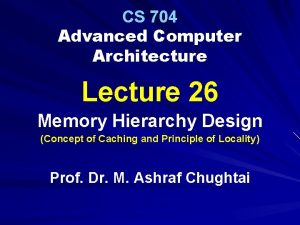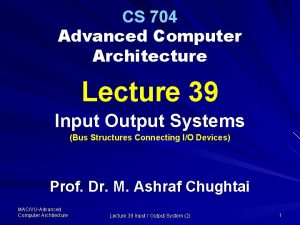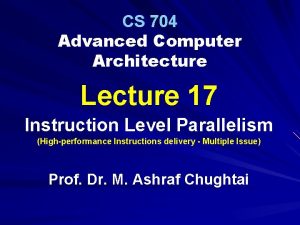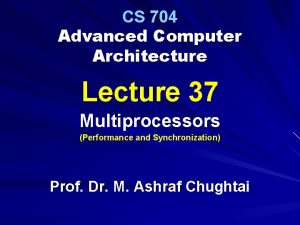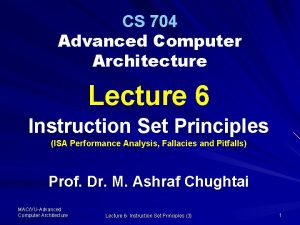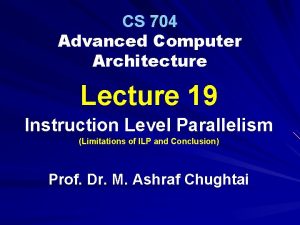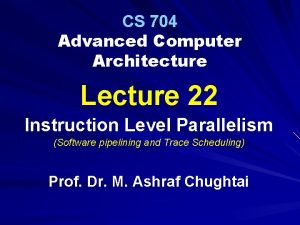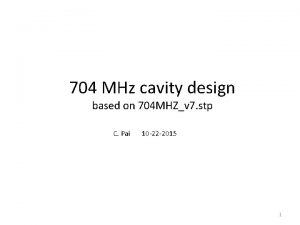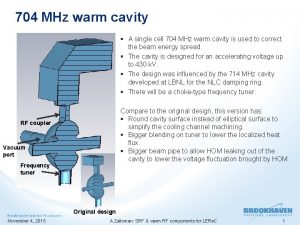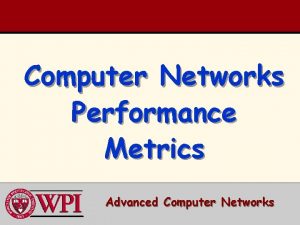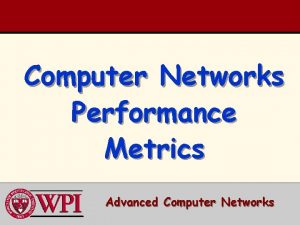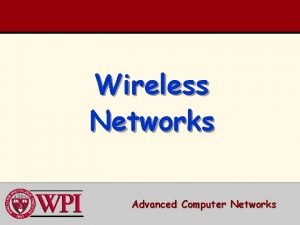CS 704 Advanced Computer Architecture Lecture 42 Networks































































- Slides: 63

CS 704 Advanced Computer Architecture Lecture 42 Networks and Clusters (Networks Topology and Internetworking. . Cont’d) Prof. Dr. M. Ashraf Chughtai

Today’s Topics Recap: Switch Topologies. . Cont’d § Centralized Switch Topology § Distributed Switch Topology Cluster Summary MAC/VU-Advanced Computer Architecture Lecture 42 Networks and Clusters (2) 2

Recap: Lecture 41 Last time we discussed: § The formation of generic interconnection networks and their categorization; § The networks communication model, performance, media, software, protocols, subnet and networks topologies Here, we noticed that a generic interconnection network comprises: MAC/VU-Advanced Computer Architecture Lecture 42 Networks and Clusters (2) 3

Recap: Lecture 41 – Computer nodes (host or end system) – H/W and S/W interface – Links to the interconnection network and – Communication subnet The interconnections are classified based on the number of processors or nodes and the distance between them as: – Local Area Network-LAN – Wide Area Network-WAN – System Area Network-SAN MAC/VU-Advanced Computer Architecture Lecture 42 Networks and Clusters (2) 4

Recap: Lecture 41 The interconnect communication model shows that two machines are connected via two unidirectional wires with a FIFO (queue) at the end to hold the data The communication software separates the header and trailer from the message and identifies the request, reply, their acknowledgments and error checking codes The communication protocols suggest the sequence of steps to reliable communication MAC/VU-Advanced Computer Architecture Lecture 42 Networks and Clusters (2) 5

Recap: Lecture 41 The network performance that defines the latency of the message as the sum of the: Sender overhead, time to flight, receiver overhead and the ratio of the message size to the bandwidth We also discussed the properties and performance of interconnect network media or link – the unshielded twisted pair (UTP), coaxial cable and fiber optics MAC/VU-Advanced Computer Architecture Lecture 42 Networks and Clusters (2) 6

Recap: Lecture 41 At the end we discussed the formation of busbased and switch-based communication subnets and introduced the network topologies Here, we observed that the bus-based LAN or Ethernet is the simplest way to interconnect more than two computers sharing a single media However, the interconnect sharing media are challenging as it requires coordination and … MAC/VU-Advanced Computer Architecture Lecture 42 Networks and Clusters (2) 7

Recap: Lecture 41 … arbitration when more than one computer needs the same media simultaneously Alternative to sharing media is to use a switch to provide a dedicated line to all destinations in order; and facilitates point-to-point communication much faster than the shared media A switch provides unidirectional interconnection of input to any one of multiple output terminals MAC/VU-Advanced Computer Architecture Lecture 42 Networks and Clusters (2) 8

Recap: Lecture 41 The switch that facilitates unidirectional interconnection of every processor to all the processors in the network is referred to as the non-blocking switch The Crossbar switch is typical example of nonblocking switch; an is employed in the centralized switching topology Last time we discussed the crossbar topology in detail and noticed that a crossbar uses n 2 switches to interconnect n processors in a network MAC/VU-Advanced Computer Architecture Lecture 42 Networks and Clusters (2) 9

Recap: Lecture 41 Here the routing, to establish interconnection between two node at a time, depends on the addressing style i. e. , source-based routing where message specifies the path to the destination or destination-based routing where the message simply contains the destination address and a program running in the switch selects the port to take for a given destination MAC/VU-Advanced Computer Architecture Lecture 42 Networks and Clusters (2) 10

Multistage Interconnect Network Today, continuing our discussion on the centralized switching topologies, we will discuss an intermediate class of network interconnect which lies between crossbar and bus-based networks This interconnect topology is referred to as the Multistage network topology A centralized multistage network, shown here, is built from number of large switch boxes, placed at multiple stages to interconnect all of the nodes MAC/VU-Advanced Computer Architecture Lecture 42 Networks and Clusters (2) 11

Multistage Interconnection Topology Each stage contains number of small crossbar switches and allows the straight or cross connections through the switch, as shown MAC/VU-Advanced Computer Architecture Lecture 42 Networks and Clusters (2) 12

Multistage Interconnection Topology The number of stages are related to the number of nodes and the size of the crossbar switch Consequently, its performance and cost are more scalable than bus-based networks The number of identical stages (Ns) in the network having n nodes and switches of size m x m, in each stage, is given as: Ns = log m n MAC/VU-Advanced Computer Architecture Lecture 42 Networks and Clusters (2) 13

Multistage Interconnection Topology And, the number of switches per stage is n/m Thus, the total number of switches used in multistage network of n nodes is n/m log m n i. e. , its cost is O(n log n) as compared O(n 2 ) for crossbar To understand the design and working of multistage networks, let us consider Omega Network, depicted here, as a typical implementation of multistage network MAC/VU-Advanced Computer Architecture Lecture 42 Networks and Clusters (2) 14

Omega Topology 000 001 Here, 8 nodes (processors), are 010 addressed using 3 - 011 100 bit code and 3 stages 101 of 2 x 2 crossbar 110 switches 111 000 001 010 011 100 101 110 111 number of identical stages [log 2 8] = 3 And, switches per stage [n/m] = 8/2 =4 MAC/VU-Advanced Computer Architecture Lecture 42 Networks and Clusters (2) 15

Omega Topology: Multistage Interconnect 000 001 S 2 S 1 S 0 001 010 011 100 101 110 111 § let us see how the switches at each stage operate to establish connection § Note that for the 8 -nodes Omega Network the node address is of 3 bits, which is equal to number of stages of the switch MAC/VU-Advanced Computer Architecture Lecture 42 Networks and Clusters (2) 16

Omega Network: Example Here, the 3 -bit code a 2 a 1 a 0 represents 3 stages of the network, as stage S 2 S 1 S 0, from left to right To find the connection pattern XOR the source and destination, e. g. , § Src (010) dest (110) then XOR results § 100 Cross (S 2) Straight (S 1) Straight (S 0) The switch connections are shown Green Circles MAC/VU-Advanced Computer Architecture Lecture 42 Networks and Clusters (2) 17

Omega Network: Example Thus, the generalized rule to find the switch connection can be summarized as § For the stage i IF the source and destination differ in ith bit THEN connection Cross the switch in the ith stage” ELSE Connection is Straight in the ith stage” MAC/VU-Advanced Computer Architecture Lecture 42 Networks and Clusters (2) 18

Characteristics of Omega There exist an single path from source to destination, thus contrary to the non-blocking crossbar network, the omega network is blocking network This is shown here as: - the path 010 110 (red) and - the path 110 100 (blue) have blockage as the S 2 for 110 has to wait till 010 has passed otherwise it results in collision MAC/VU-Advanced Computer Architecture Lecture 42 Networks and Clusters (2) 19

Omega Network Characteristics …. Cont’d 000 001 S 2 S 1 S 0 001 010 011 100 101 110 111 However, in order to minimize collisions and to improve fault tolerance to achieve high reliability and dependability extra pathways can be added MAC/VU-Advanced Computer Architecture Lecture 42 Networks and Clusters (2) 20

S 1 Butterfly Network Alternative to the Omega Topology of multistage switching, is Butterfly Network shown here 000 001 S 2 S 1 S 0 001 010 011 100 101 110 111 Here, irrespective of the source address, for the destination a 2 a 1 a 0, the ith stage switch sends to: Upper port if ai = 0 and to Lower port if ai = 1 MAC/VU-Advanced Computer Architecture Lecture 42 Networks and Clusters (2) 21

Distributed Switch Networks So far we have been discussing the Centralized switching topologies The distributed switching network is one where the switches are distributed throughout the network and they allow interconnection of one node to: § either all the nodes § or to a limited number of nodes A C B MAC/VU-Advanced Computer Architecture D Lecture 42 Networks and Clusters (2) 22

Distributed Switch Networks A network where each node interconnects all nodes of the network is called, Fully connected network . . Cont’d B C A D There exist different interconnects for distributed switch networks Before discussing these interconnects, let us understand the parameters of interconnect performance measure MAC/VU-Advanced Computer Architecture Lecture 42 Networks and Clusters (2) 23

Interconnect Performance Measure Criteria Latency: Number of Links and must be small Bandwidth: The number of messages or the length of massages; it should be large Node Degree: Number of links connected to a node Diameter: Maximum distance between any two processors, i. e. , the number of nodes between source and destination; this is in deed the measure of maximum latency MAC/VU-Advanced Computer Architecture Lecture 42 Networks and Clusters (2) 24

Performance Measure Criteria … Cont’d Bisect: The imaginary line that divides the interconnect into roughly two equal parts, each having half the nodes Bisection Bandwidth: Sum of the bandwidth of lines crossing the imaginary bisection line It measures the volume of communication allowed between any two halves of network with equal number of nodes MAC/VU-Advanced Computer Architecture Lecture 42 Networks and Clusters (2) 25

Parameters of Interconnect Performance Measure Note that the bisect is not clear in nonsymmetric networks, therefore, in order to draw the bisect line the bisection band-width is considered Furthermore, it is to be noted that the bisection bandwidth is the worst-case metric of non-symmetric interconnect Therefore, the division or the bisect line that makes the bandwidth worst is chosen MAC/VU-Advanced Computer Architecture Lecture 42 Networks and Clusters (2) 26

Distributed Switch Topologies Based on the concept of distributed-switch interconnects, there exist numerous topologies The most popular and commercially available are: § Linear Array and Ring § Fully Connected § 2 D Mesh and Torus § Hypercube § Tree MAC/VU-Advanced Computer Architecture Lecture 42 Networks and Clusters (2) 27

Linear Array / Ring The simplest possible, low cost distributed switch network topology, is a linear array and ring network As shown here, the Linear Array networks is one where a small switch is placed at every node (processor) MAC/VU-Advanced Computer Architecture Lecture 42 Networks and Clusters (2) 28

Linear Array / Ring The switch at the i th node connects the ith node to the: § (i-1) th node except for i=1, and § (i+1) th node except for i =n In the linear array, as the i th node is connected to (i-1) th and (i+1) th node, therefore the message will have to hop along intermediate node until it arrives at the final destination at (i ± m) where m>1 MAC/VU-Advanced Computer Architecture Lecture 42 Networks and Clusters (2) 29

Linear Array / Ring For example, where the message is to pass from 1 st node is to the 4 th node, it hops the 2 nd and 3 rd nodes The ring network is established by establishing an interconnect between the 1 st and the nth nodes in the linear array network MAC/VU-Advanced Computer Architecture Lecture 42 Networks and Clusters (2) 30

Ring /Token Ring Like linear array, in Ring network some massages hop along the intermediate nodes until they reach destination However, it allows many transfers simultaneously; the 1 st node can send to the 2 nd at the same time as the 3 rd can send to 4 th and so on. A variation called Token Ring is used in the Ring Network, to simplify the arbitration in the ring topology MAC/VU-Advanced Computer Architecture Lecture 42 Networks and Clusters (2) 31

Ring Network Here, a single slot (token) goes around the ring to determine which node is allowed to send the message – a node can send a message if it gets a token The common performance of an n - node linear array and ring network are as follows: § Cost: Cheap as the cost is O(n) § Bandwidth: Overall bandwidth is high § Latency: High as it is of O(N) MAC/VU-Advanced Computer Architecture Lecture 42 Networks and Clusters (2) 32

Performance: Array verses Ring Linear Array § Degree: 2 § Diameter : N Bisection width = 1 § Bandwidth = N-1 § § Mean Latency = N/2 § § Asymmetric § § Heterogeneous § § § MAC/VU-Advanced Computer Architecture Degree: 2 Diameter : N/2 Bisection Width = 2 Bandwidth = N Latency = N/2 Symmetric Homogeneous Lecture 42 Networks and Clusters (2) 33

Fully Connected A straight forward, symmetric but expensive distributed network, equivalent of the crossbar network, is Fully connected network Here, very node has a direct link with all the other nodes of the network As shown here the node A is interconnected with the nodes B, C, and D B Its performance metrics are as follows: MAC/VU-Advanced Computer Architecture C A Lecture 42 Networks and Clusters (2) D 34

Fully Connected: Performance Metrics § Diameter = 1 B § Degree = n-1 C A § Links = n * (n-1)/2 § Bisects = n * n/5 and D § Bisection bandwidth is proportional to (n/2)2 MAC/VU-Advanced Computer Architecture Lecture 42 Networks and Clusters (2) 35

2 D Mesh and 2 D Torus Two dimensional Mesh or Grid is an example of asymmetric network topology and uses bisection bandwidth as the performance metric Here, the nodes (processors) are arranged in a array structure forming 2 D Grid or Mesh An example 3 x 4 mesh structure is shown here MAC/VU-Advanced Computer Architecture P P P Lecture 42 Networks and Clusters (2) 36

2 D Mesh and 2 D Torus A switch is associated to each (processor) node [shown as blue circle] Each switch has one port for the processor and four ports to interconnect the processor to the four nearest-neighbor nodes, i. e. , the nodes to the left - right and up - down position This structure is sometimes also referred to as NEWS communication pattern, representing North, East, West and South communication MAC/VU-Advanced Computer Architecture Lecture 42 Networks and Clusters (2) 37

2 D Mesh and 2 D Torus Note that here the switches associated with the top/bottom rows or left/right columns don’t connect among themselves, thus have unused ports Connecting the unused ports of switches of the top/bottom rows and the left/right columns forms 2 D Torus, using wraparound links, as shown here MAC/VU-Advanced Computer Architecture Lecture 42 Networks and Clusters (2) 38

2 D Mesh / Torus: Performance Metrics § § § The performance metrics of n-node 2 D Mesh / Torus are as follows Degree = 4 Diameter = 2√N Bisection width = √N Bandwidth = N Asymmetric MAC/VU-Advanced Computer Architecture Lecture 42 Networks and Clusters (2) 39

Tree Network Topology Another example of distributed switch network is the Tree Topology Here, the switches associated with each node have the number of ports equal to the number of braches of the tree plus one for the processor A Binary Tree structure shown here has two branches of the root node and branch nodes MAC/VU-Advanced Computer Architecture Lecture 42 Networks and Clusters (2) 40

Tree Network: Performance Metrics The performance metrics of N-nodes Tree Network are as follows Cost: It is cheap as cost is O(N) Degree: Number of branches 1, 2, 3 … Latency: O(log deg N) Diameter: 2 log deg N Bisection Width: 1 MAC/VU-Advanced Computer Architecture Lecture 42 Networks and Clusters (2) 41

Tree Network: Bottlenecks The root node and the branch nodes of the leafnodes are the bottleneck For example, leaf-nodes 1, 2 of the branch nodes 9 13 and 3, 4 of branch node 10, may be interconnect 10 9 ed simultaneously, but the leaf-nodes 1, 3 and 2, 4 cannot, as there may be collision at branch 1 2 3 4 nodes 13, 9 and 10 MAC/VU-Advanced Computer Architecture Lecture 42 Networks and Clusters (2) 15 14 11 12 5 6 7 8 42

Fat Tree Network To avoid root being the bottleneck, multiple paths are provided between any two nodes, as shown here This structure is called the Fat Trees MAC/VU-Advanced Computer Architecture Lecture 42 Networks and Clusters (2) 43

Fat Tree Network Here, the black dots show the processormemory nodes connected through the multiple stages of 2 x 2 crossbar, 4 x (2+2) crossbar and 8 x (4+4) crossbars switches and so on This 3 D switching increase the bandwidth via extra links at each level over the simple tree In CM-5 the concept of Fat Tree is used as Centralized switching Network MAC/VU-Advanced Computer Architecture Lecture 42 Networks and Clusters (2) 44

Hypercube Network Topology Another example of distributed switch network is the Hypercube topology which is also called binary n-cubes, as it has 2 nodes of n-cubes It is an n-dimensional interconnect for 2 n nodes As can be seen from the figure here, that for 16 nodes; the hyper cube is a 4 D structure as N=16 = 24 therefore n=4 MAC/VU-Advanced Computer Architecture Lecture 42 Networks and Clusters (2) 45

Hypercube Network Topology It requires n ports per switch plus one for the processor this have n nearest neighbors nodes Thus, it minimizes hops and have latency of O(log 2 N); the other performance metrics are: MAC/VU-Advanced Computer Architecture Lecture 42 Networks and Clusters (2) 46

Hypercube Network Topology Nodes = N= 2 n Degree = n; Diameter = n Links = n * 2(n-1) Bisection width = 2(n-1) The other topologies, such as tree, mesh etc. , can be embedded in hypercube Note that the bisection bandwidth is good but it is difficult to layout in 3 D space Hypercube has been popular in early message passing machines, e. g. , Intel i. PSC, NCUBE etc MAC/VU-Advanced Computer Architecture Lecture 42 Networks and Clusters (2) 47

K-ary n-cube Network Topology Rather than having just 2 nodes of n-cubes in the binary hypercube, the generalization of hypercube is to interconnect k nodes of ncubes in a string The total number of nodes: N= k n A 64 node, where 64 = 43 [4 ary 3 cube) structure is shown here This structure allows for wider channel but requires more hops MAC/VU-Advanced Computer Architecture Lecture 42 Networks and Clusters (2) 48

K-ary n-cube Network Topology 64 = 43 [4 -ary 3 -cube) (3 cube is a 16 nodes binary hypercube) MAC/VU-Advanced Computer Architecture Lecture 42 Networks and Clusters (2) 49

Comparing Network Topologies The relative cost and performance of topologies discussed, based on the bisection bandwidth and number of links for 64 nodes network is given in the table here Evaluation Bus Category Ring 2 D Torus Fully Connected Performance: Bisection Bandwidth 1 2 16 1024 Cost Ports/switch N/A Total Links 1 MAC/VU-Advanced Computer Architecture 3 5 64 128 192 2080 Lecture 42 Networks and Clusters (2) 50

Comparing Network Topologies Here, bus is used as the standard reference at unit cost, all transfers are done by taking the time units equal to the number of messages Where as the fully connected network has all nodes at equal distance therefore the number of links and ports per switch are maximum and all transfers are done in parallel taking only unit time The nodes for ring topology are differing distances MAC/VU-Advanced Computer Architecture Lecture 42 Networks and Clusters (2) 51

Comparing Network Topologies Here, bus is used as the standard reference at unit cost, all transfers are done by taking the time units equal to the number of messages Where as the fully connected network has all nodes at equal distance therefore the number of links and ports per switch are maximum and all transfers are done in parallel taking only unit time The nodes for ring topology are differing distances MAC/VU-Advanced Computer Architecture Lecture 42 Networks and Clusters (2) 52

Internetworking deals with the communication of computers on independent and incompatible networks reliably and efficiently The software standards are the basic enabling technologies of internetworking (Transmission Control Protocol/Internet Protocol) TCP/IT is the most popular internetworking standard The detailed discussion on Internetworking is beyond the scope of this course MAC/VU-Advanced Computer Architecture Lecture 42 Networks and Clusters (2) 53

Cluster Internetworking deals with the communication of computers on independent and incompatible networks reliably and efficiently The software standards are the basic enabling technologies of internetworking (Transmission Control Protocol/Internet Protocol) TCP/IT is the most popular internetworking standard The detailed discussion on Internetworking is beyond the scope of this course MAC/VU-Advanced Computer Architecture Lecture 42 Networks and Clusters (2) 54

Thanks and Allah Hafiz MAC/VU-Advanced Computer Architecture Lecture 42 Networks and Clusters (2) 55

Summary Today, we discussed an intermediate class of network interconnect which lies between crossbar and bus-based networks, referred to as the Multistage Switch network topology A multistage centralized switch is built from number of large switch boxes, placed at number of stages to interconnect all of the nodes Here, The number of identical stages (Ns) in the network having n nodes and switches in each stage are of size m x m is as given as: MAC/VU-Advanced Computer Architecture Lecture 42 Networks and Clusters (2) 56

Multistage Interconnection Topology MAC/VU-Advanced Computer Architecture Lecture 42 Networks and Clusters (2) 57

Multistage Interconnection Topology And, the number of switches per stage is n/m Thus, the total number of switches used in multistage network of n nodes is n/m log m n i. e. , its cost is O(n log n) as compared O(n 2 ) for crossbar To understand the design and working of multistage networks, let us consider Omega Network, depicted here, as a typical implementation of multistage network MAC/VU-Advanced Computer Architecture Lecture 42 Networks and Clusters (2) 58

Omega Topology 000 001 Here, 8 nodes (processors), are 010 addressed using 3 - 011 100 bit code and 3 stages 101 of 2 x 2 crossbar 110 switches 111 000 001 010 011 100 101 110 111 number of identical stages [log 2 8] = 3 And, switches per stage [n/m] = 8/2 =4 MAC/VU-Advanced Computer Architecture Lecture 42 Networks and Clusters (2) 59

Omega Topology: Multistage Interconnect 000 001 S 2 S 1 S 0 001 010 011 100 101 110 111 § let us see how the switches at each stage operate to establish connection § Note that for the 8 -nodes Omega Network the node address is of 3 bits, which is equal to number of stages of the switch MAC/VU-Advanced Computer Architecture Lecture 42 Networks and Clusters (2) 60

Omega Network: Example Here, the 3 -bit code a 2 a 1 a 0 represents 3 stages of the network, as stage S 2 S 1 S 0, from left to right To find the connection pattern XOR the source and destination, e. g. , § Src (010) dest (110) then XOR results § 100 Cross (S 2) Straight (S 1) Straight (S 0) The switch connections are shown Green Circles MAC/VU-Advanced Computer Architecture Lecture 42 Networks and Clusters (2) 61

Omega Network: Example Thus, the generalized rule to find the switch connection can be summarized as § For the stage i IF the source and destination differ in ith bit THEN connection Cross the switch in the ith stage” ELSE Connection is Straight in the ith stage” MAC/VU-Advanced Computer Architecture Lecture 42 Networks and Clusters (2) 62

Characteristics of Omega There exist an single path from source to destination, thus contrary to the non-blocking crossbar network, the omega network is blocking network This is shown here as: - the path 010 110 (red) and - the path 110 100 (blue) have blockage as the S 2 for 110 has to wait till 010 has passed otherwise it results in collision MAC/VU-Advanced Computer Architecture Lecture 42 Networks and Clusters (2) 63
 Difference between virtual and datagram circuit
Difference between virtual and datagram circuit Basestore iptv
Basestore iptv Computer architecture lecture notes
Computer architecture lecture notes Isa definition computer
Isa definition computer Bluetooth in computer networks
Bluetooth in computer networks Osi network architecture
Osi network architecture Ec 6009
Ec 6009 Tpp 704 01
Tpp 704 01 Afi 36 704
Afi 36 704 704-631-1500
704-631-1500 Mc-338
Mc-338 Irc 704
Irc 704 ความอันตราย
ความอันตราย Iso 704
Iso 704 704 kar 3:305
704 kar 3:305 704 error
704 error 01:640:244 lecture notes - lecture 15: plat, idah, farad
01:640:244 lecture notes - lecture 15: plat, idah, farad Advanced inorganic chemistry lecture notes
Advanced inorganic chemistry lecture notes Three bus architecture
Three bus architecture Difference between architecture and organisation
Difference between architecture and organisation Flow chart for interrupt cycle
Flow chart for interrupt cycle Single node architecture in wsn
Single node architecture in wsn Computer security 161 cryptocurrency lecture
Computer security 161 cryptocurrency lecture Computer-aided drug design lecture notes
Computer-aided drug design lecture notes Crc in computer networks
Crc in computer networks Crc in computer networks
Crc in computer networks Traffic management in computer networks
Traffic management in computer networks Tpdu in computer networks
Tpdu in computer networks What is optimality principle in computer networks
What is optimality principle in computer networks In band management definition
In band management definition What is optimality principle in computer networks
What is optimality principle in computer networks Uses of computer network
Uses of computer network Definition of computer
Definition of computer Intro dns
Intro dns Difference between intserv and diffserv
Difference between intserv and diffserv Icmp in computer networks
Icmp in computer networks Web and http in computer networks
Web and http in computer networks Framing in computer network
Framing in computer network Dns in computer networks
Dns in computer networks Computer network assignment
Computer network assignment Network vs distributed system
Network vs distributed system Badrinath
Badrinath Crc error detection
Crc error detection Error detection and correction in computer networks
Error detection and correction in computer networks Internet transport protocol in computer networks
Internet transport protocol in computer networks Error control in computer networks
Error control in computer networks Subnet
Subnet Switching in data link layer
Switching in data link layer Explain the concept of layered task
Explain the concept of layered task Bit stuffing and byte stuffing difference
Bit stuffing and byte stuffing difference Bit stuffing and byte stuffing
Bit stuffing and byte stuffing What is character stuffing in computer network
What is character stuffing in computer network Explain berkeley socket primitives
Explain berkeley socket primitives What is the reverse request protocol
What is the reverse request protocol In ftp protocol client contacts server using
In ftp protocol client contacts server using Principles of network applications in computer networks
Principles of network applications in computer networks Switching techniques in computer networks
Switching techniques in computer networks 15441 cmu
15441 cmu Utopian simplex protocol in computer networks
Utopian simplex protocol in computer networks Sonet in computer networks
Sonet in computer networks Connectionless internetworking
Connectionless internetworking Physical structures in computer networks
Physical structures in computer networks Responsibility of presentation layer
Responsibility of presentation layer The network layer is concerned with of data.
The network layer is concerned with of data.





